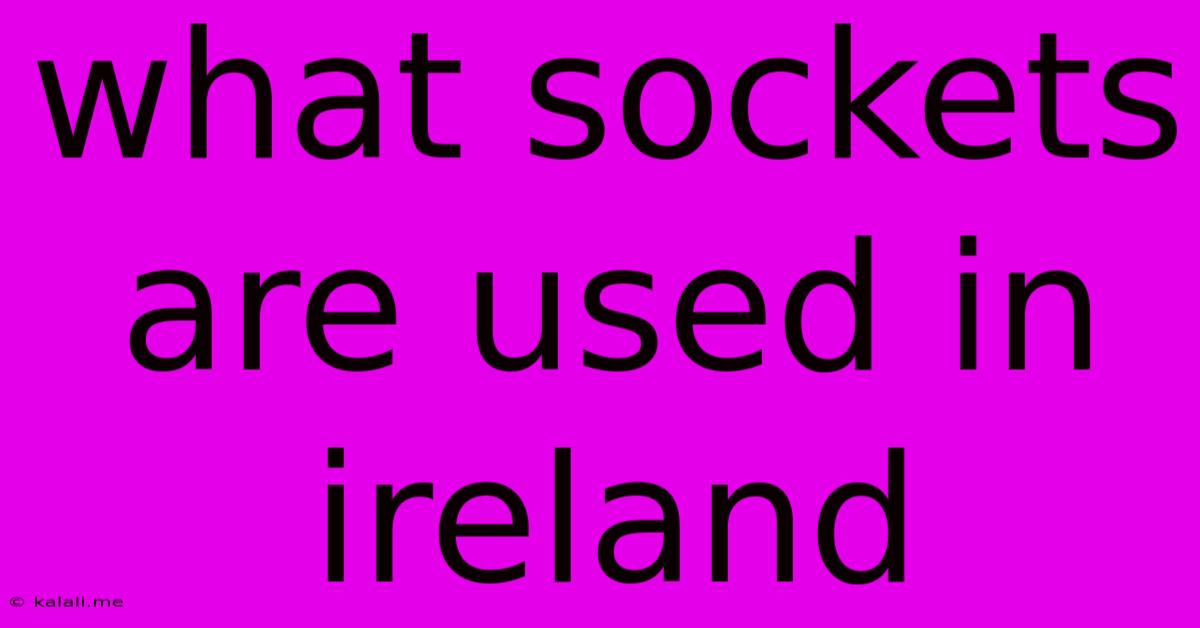What Sockets Are Used In Ireland
Kalali
May 21, 2025 · 3 min read

Table of Contents
What Sockets Are Used in Ireland? A Comprehensive Guide
Meta Description: Planning a trip to Ireland or moving there? This guide clarifies the type of electrical sockets used in Ireland, voltage levels, and adapter recommendations to ensure your devices are safe and functional.
Ireland uses two-pin plugs, also known as Type G plugs. These are characterized by their rectangular shape and two round pins, which are often slightly wider than those found in other two-pin systems. Understanding this is crucial before you plug in any electrical devices. This article will delve into the specifics of Irish sockets, voltage, and the adapters you might need.
Understanding Irish Electrical Sockets (Type G)
The Type G socket is a common standard in the UK and Ireland. Its distinctive features include:
- Two round pins: These are the primary conductors for power.
- Rectangular shape: The socket's casing is rectangular and usually made of plastic.
- Earth grounding: While the primary pins carry the current, many (but not all) Irish sockets incorporate an earth connection, usually a third grounding pin located at the top of the plug. This is a crucial safety feature that grounds the device to prevent electric shock.
It's important to note that older buildings might have older, less standardized sockets. However, the vast majority of modern sockets in Ireland will conform to the Type G standard.
Voltage and Frequency in Ireland
Besides the plug type, it's equally important to know the voltage and frequency of the electricity supply. In Ireland, the standard voltage is 230V and the frequency is 50Hz. This differs from North America (120V, 60Hz) and some other parts of the world, meaning direct use of many appliances without an adapter or converter could damage your devices.
Adapters vs. Converters: What You Need
When travelling to Ireland, you'll likely need either an adapter or a converter, depending on your devices:
-
Adapter: An adapter simply changes the shape of your plug to fit the Irish socket. It doesn't alter the voltage or frequency. You only need an adapter if your plug's shape is different from the Type G plug. Many dual-voltage appliances will work fine with just an adapter.
-
Converter: A converter alters the voltage and/or frequency to match the Irish standard. You need a converter if your appliance is not dual-voltage and its voltage/frequency rating differs from the Irish standard (230V, 50Hz). Using an appliance with the incorrect voltage can damage or destroy the appliance.
Therefore, check the voltage and frequency requirements on your electrical devices before your trip. This will help you determine whether you only need an adapter or both an adapter and a converter.
Finding the Right Adapter/Converter
Adapters and converters are widely available online and in electronics stores. When purchasing, ensure it explicitly states compatibility with Irish sockets (Type G). Look for reputable brands to ensure the safety of your devices. Always prioritize safety and avoid cheap, poorly made adapters or converters.
Conclusion: Powering Up Your Trip to Ireland
Understanding the electrical system in Ireland is a crucial aspect of planning your visit. By knowing that Ireland uses Type G sockets, 230V voltage, and 50Hz frequency, and understanding the differences between adapters and converters, you can ensure your devices are safe and functional throughout your stay. Remember to always check the voltage requirements of your devices before plugging them in!
Latest Posts
Latest Posts
-
Can You Take An Xbox On A Plane
May 21, 2025
-
Can I Tile Over A Painted Wall
May 21, 2025
-
How Long Can I Keep Bolognese In The Fridge
May 21, 2025
-
How To Take Off A Locked Door Handle
May 21, 2025
-
How Long Is A Doctorate Dissertation
May 21, 2025
Related Post
Thank you for visiting our website which covers about What Sockets Are Used In Ireland . We hope the information provided has been useful to you. Feel free to contact us if you have any questions or need further assistance. See you next time and don't miss to bookmark.